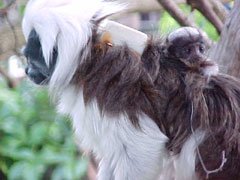Studying Animal Reproductive Functioning
One important aspect of caring for animals both in zoos and in the wild is understanding how they reproduce. Zoo professionals need to carefully monitor breeding of animals in our care to make sure that we can provide them with the best of care. Researchers in the Wildlife Tracking Center at Disney's Animal Kingdom are constantly studying the reproductive functioning of animals so that we can have the most up-to-date information to assist us in making important decisions.
How can you tell if a white rhino is pregnant? Researchers use techniques much like home pregnancy tests to provide us this information. We measure hormones (chemicals in the body) to tell us if an animal can get pregnant, if she is pregnant, and even when she is about to give birth to a baby.
Believe it or not, most of the information we need can be obtained from measuring hormones in urine or fecal samples and sometimes from saliva and even sweat! Each of these is very easy to gather and has very little impact on the animal that we are studying. You can learn a lot from what comes out of an animal. After all, it's all in a drop, it's all in a plop!

Cotton-top tamarin with infant |
Researchers in the Wildlife Tracking Center are monitoring hormones in a variety of species: white and black rhinos, African elephants, okapi, mandrills, cotton-top tamarins (shown to the left), and hippos. (For information on long-term preservation of the endangered cotton-top tamarin, click here.) |
By examining how hormones levels change over time, we can figure out when females are pregnant.
What We Can Learn from What an Animal Leaves Behind:
"It's all in a drop … it's all in a plop"
How do we know if our animals are pregnant, going through puberty, or even starting menopause? We determine the reproductive status of our animals by measuring and monitoring hormones such as progesterone (the hormone of pregnancy) and estrogen. The most accurate method to measure hormones is from blood samples, but sometimes obtaining a blood sample can be a challenging task. So we look for innovative methods to measure hormones, such as those found in urine and feces. As the animals wake up, our animal keepers use a variety of techniques to collect urine or feces from them. The samples are then brought to the lab and we can measure the hormones. Best of all, whether in a "plop or a drop," we can easily collect samples and measure hormones with little or no stress to our animals!
Important Research Underway at Disney's Animal Kingdom
Making Discoveries in Reproductive Biology
At Disney's Animal Kingdom, one aspect of our research focuses on the reproductive functioning of animals in our collection at the park, as well as those in the wild. With some species we have to focus on encouraging breeding. However, some species breed very well and we have a limited number of spaces available for them at Disney's Animal Kingdom or in other zoos. So we are developing new contraceptive methods to assist in management of captive populations. Given our successful breeding of hippos over the past five years, our scientists have produced the first information characterizing puberty and the reproductive cycle in captive hippos. These scientists are now working on contraceptive trials to assist us in managing our animal populations.
The first study to characterize the reproductive biology of the Nile hippopotamus was conducted and completed at Disney's Animal Kingdom. Reproductive cycles and pregnancies were monitored in nine female hippos. Scientists analyzed the fecal progestagens, a type of progesterone. They observed that the ovarian cycles of females throughout the year lasted little over one month (35.3 +/- 1.3 days). Pregnancies lasted about 7 ½ months (231.9 +/- 2.7 days), with most of the births occurring during the rainy season. Most of the females showed a suppression of ovulation and reproductive cycles while nursing that could last as long as eight months following the first pregnancy (33.9 +/- 1.8 weeks). Subsequent pregnancies were not always followed by a suppression of cycles, and some females cycled immediately following birth. (see Fig 1 for sidebar)

Figure: Fecal progestagen profiles in a single female hippopotamus
showing ovarian cycles (dashed lines), pregnancy (solid blue line),
and birth (arrow).
The ability of hippos to reproduce rapidly has focused attention toward identifying new ways to contracept these animals. For the best results, contraceptives need to be reliable, effective, easy to administer, and reversible. Hippos present many challenges in the development of a good contraceptive. Their massive size and thick skin make surgical implants and injections difficult. Contraceptive trials conducted in 2001 using a contraceptive called Depo-Provera ™ showed some promise, with protection from pregnancy for approximately 100 days. One female conceived after 100 days even though reproductive cycles persisted. Later trials with increased dosage of Depo showed either moderate suppression of cycles or complete suppression of cycles in different females. A new contraceptive study for hippos that started in November 2001 using MGA (melengestrol acetate), a synthetic progesterone milled into the animals' feed has shown great promise.

Figure: Fecal progestagen profiles in a single female hippopotamus
contracepted using 800 mg and 1200 mg of Depo-Provera ™ (red arrows).
Effective contraception (suppressed cycles) occurred with 1200 mg dose
and was effective for approximately 100 days.
We continue to monitor reproductive cycles and pregnancy in a number of our animals, including hippopotamus, African elephant, giraffe, okapi, black rhino, white rhino, cotton-top tamarin, and mandrill.
REFERENCES
Graham, L, Schwarzenberger, F., Möstl, E., Galama, W. & Anne Savage. 2001. A Versatile Enzyme-Immunoassay for the Determination of Progestagens in Feces and Serum. Zoo Biology 20:227-236.
Graham, L, Reid, K., Webster, T., Richards, M., Joseph, S. 2002. Endocrine patterns associated with reproduction in the Nile Hippopotamus (Hippopotamus amphibius) as assessed by fecal progestagen analysis. General and Comparative Endocrinology (in press 2002).